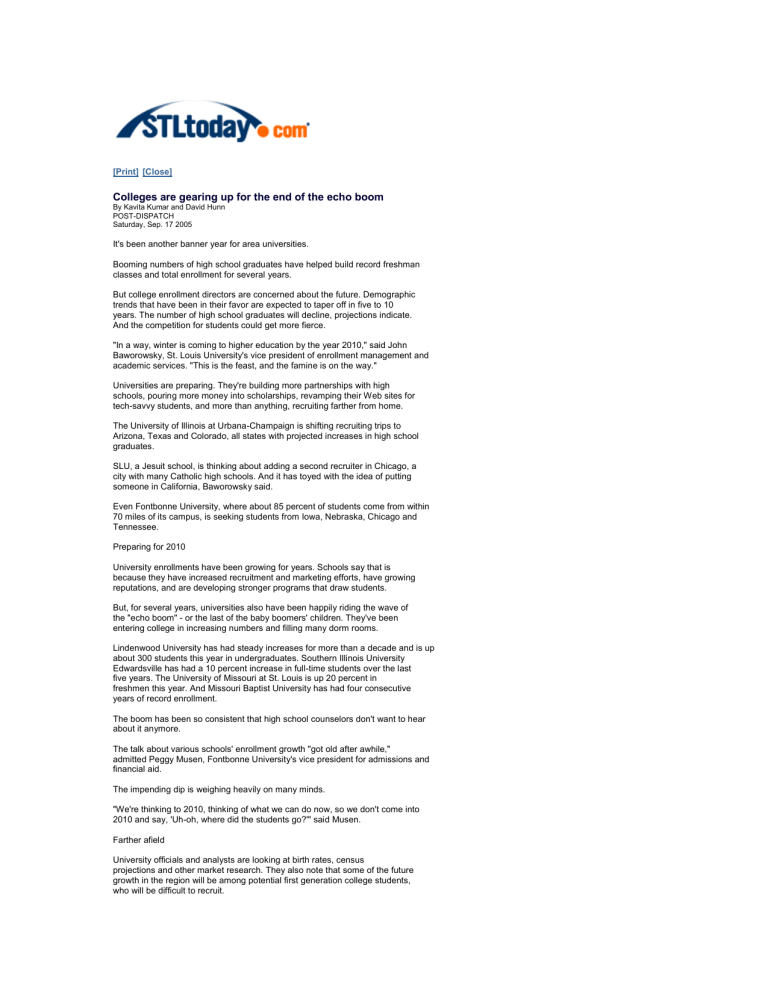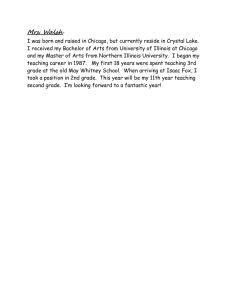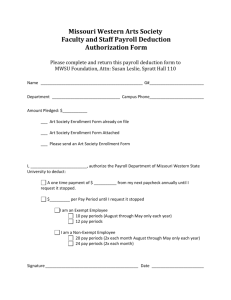COLLEGESECHOBOOM.doc

[Print] [Close]
Colleges are gearing up for the end of the echo boom
By Kavita Kumar and David Hunn
POST-DISPATCH
Saturday, Sep. 17 2005
It's been another banner year for area universities.
Booming numbers of high school graduates have helped build record freshman classes and total enrollment for several years.
But college enrollment directors are concerned about the future. Demographic trends that have been in their favor are expected to taper off in five to 10 years. The number of high school graduates will decline, projections indicate.
And the competition for students could get more fierce.
"In a way, winter is coming to higher education by the year 2010," said John
Baworowsky, St. Louis University's vice president of enrollment management and academic services. "This is the feast, and the famine is on the way."
Universities are preparing. They're building more partnerships with high schools, pouring more money into scholarships, revamping their Web sites for tech-savvy students, and more than anything, recruiting farther from home.
The University of Illinois at Urbana-Champaign is shifting recruiting trips to
Arizona, Texas and Colorado, all states with projected increases in high school graduates.
SLU, a Jesuit school, is thinking about adding a second recruiter in Chicago, a city with many Catholic high schools. And it has toyed with the idea of putting someone in California, Baworowsky said.
Even Fontbonne University, where about 85 percent of students come from within
70 miles of its campus, is seeking students from Iowa, Nebraska, Chicago and
Tennessee.
Preparing for 2010
University enrollments have been growing for years. Schools say that is because they have increased recruitment and marketing efforts, have growing reputations, and are developing stronger programs that draw students.
But, for several years, universities also have been happily riding the wave of the "echo boom" - or the last of the baby boomers' children. They've been entering college in increasing numbers and filling many dorm rooms.
Lindenwood University has had steady increases for more than a decade and is up about 300 students this year in undergraduates. Southern Illinois University
Edwardsville has had a 10 percent increase in full-time students over the last five years. The University of Missouri at St. Louis is up 20 percent in freshmen this year. And Missouri Baptist University has had four consecutive years of record enrollment.
The boom has been so consistent that high school counselors don't want to hear about it anymore.
The talk about various schools' enrollment growth "got old after awhile," admitted Peggy Musen, Fontbonne University's vice president for admissions and financial aid.
The impending dip is weighing heavily on many minds.
"We're thinking to 2010, thinking of what we can do now, so we don't come into
2010 and say, 'Uh-oh, where did the students go?'" said Musen.
Farther afield
University officials and analysts are looking at birth rates, census projections and other market research. They also note that some of the future growth in the region will be among potential first generation college students, who will be difficult to recruit.
Enrollments will not be flat forever. According to a recent report by the U.S.
Department of Education, overall growth of high school graduates will continue over time, though it will be markedly slower in the Midwest than in other regions. Illinois appears to be slightly better off than Missouri.
So many Missouri schools are creeping farther into Illinois to recruit, especially in the Chicago area; Illinois schools are coming across the border, too. Indeed, most schools are looking out of state:
Southern Illinois University Edwardsville now has billboards on St. Louis roads, and advertisements on St. Louis radio and TV. And this year, the school has expanded recruiting trips into west St. Louis County, where the school is finding students who want to go to SIUE.
The University of Missouri at Columbia now has full-time recruiters in Dallas and Chicago, two areas where it has significantly increased enrollment. The school also recently added a staff person in Kansas City and is thinking about doing more in Tulsa, Okla., Omaha, Neb., and Minneapolis.
Maryville University is expanding its recruiting into Chicago, Indiana,
Memphis and Arkansas.
The University of Missouri at St. Louis recently added a full-time admissions officer in Kansas City who will also attend college fairs in Kansas.
Washington University has been keeping its enrollment fairly steady for several years even while applications have increased. It already actively recruits all over the country and world.
McKendree College may be least affected by the dip, said Mark Campbell, vice president for enrollment management. The college, with 1,300 students, is just too small.
"We're going out and trying to find a couple of good students at 200 high schools a year," he said. If the senior class has 500 instead of 600, that's just not going to affect his recruiting, Campbell said.
Finding students is a matter of self-preservation. Schools that are tuition-dependent and lose students would have to downsize, said Deborah Dey, vice president for enrollment management at Webster University.
"We need the students," she said.



